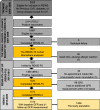Validation of eGFR for Detecting Associations Between Serum Protein Biomarkers and Subsequent GFR Decline
- PMID: 37093083
- PMCID: PMC10400103
- DOI: 10.1681/ASN.0000000000000147
Validation of eGFR for Detecting Associations Between Serum Protein Biomarkers and Subsequent GFR Decline
Erratum in
-
Correction: Validation of eGFR for Detecting Associations between Serum Protein Biomarkers and Subsequent GFR Decline.J Am Soc Nephrol. 2024 Jul 1;35(7):980-983. doi: 10.1681/ASN.0000000000000381. Epub 2024 May 21. J Am Soc Nephrol. 2024. PMID: 38625741 Free PMC article. No abstract available.
Abstract
Significance statement: eGFR from creatinine, cystatin C, or both has been primarily used in search of biomarkers for GFR decline. Whether the relationships between biomarkers and eGFR decline are similar to associations with measured GFR (mGFR) decline has not been investigated. This study revealed that some biomarkers showed statistically significant different associations with eGFR decline compared with mGFR decline, particularly for eGFR from cystatin C. The findings indicate that non-GFR-related factors, such as age, sex, and body mass index, influence the relationship between biomarkers and eGFR decline. Therefore, the results of biomarker studies using eGFR, particularly eGFRcys, should be interpreted with caution and perhaps validated with mGFR.
Background: Several serum protein biomarkers have been proposed as risk factors for GFR decline using eGFR from creatinine or cystatin C. We investigated whether eGFR can be used as a surrogate end point for measured GFR (mGFR) when searching for biomarkers associated with GFR decline.
Methods: In the Renal Iohexol Clearance Survey, GFR was measured with plasma iohexol clearance in 1627 individuals without diabetes, kidney, or cardiovascular disease at baseline. After 11 years of follow-up, 1409 participants had one or more follow-up GFR measurements. Using logistic regression and interval-censored Cox regression, we analyzed the association between baseline levels of 12 serum protein biomarkers with the risk of accelerated GFR decline and incident CKD for both mGFR and eGFR.
Results: Several biomarkers exhibited different associations with eGFR decline compared with their association with mGFR decline. More biomarkers showed different associations with eGFRcys decline than with eGFRcre decline. Most of the different associations of eGFR decline versus mGFR decline remained statistically significant after adjustment for age, sex, and body mass index, but several were attenuated and not significant after adjusting for the corresponding baseline mGFR or eGFR.
Conclusions: In studies of some serum protein biomarkers, eGFR decline may not be an appropriate surrogate outcome for mGFR decline. Although the differences from mGFR decline are attenuated by adjustment for confounding factors in most cases, some persist. Therefore, proposed biomarkers from studies using eGFR should preferably be validated with mGFR.
Copyright © 2023 by the American Society of Nephrology.
Conflict of interest statement
T. Melsom reports Honoraria: Novo Nordisk Norway AS, lecture at a local meeting. M.D. Solbu reports Honoraria: AstraZeneca; Advisory or Leadership Role: Baxter and Vifor Pharma; and Other Interests or Relationships: ERA-EDTA, ISN, Norwegian Society of Hypertension, and Norwegian Society of Nephrology. All remaining authors have nothing to disclose.
Figures


Similar articles
-
Self-reported Race, Serum Creatinine, Cystatin C, and GFR in Children and Young Adults With Pediatric Kidney Diseases: A Report From the Chronic Kidney Disease in Children (CKiD) Study.Am J Kidney Dis. 2022 Aug;80(2):174-185.e1. doi: 10.1053/j.ajkd.2021.10.013. Epub 2021 Dec 30. Am J Kidney Dis. 2022. PMID: 34974031 Free PMC article.
-
Residual Associations of Inflammatory Markers with eGFR after Accounting for Measured GFR in a Community-Based Cohort without CKD.Clin J Am Soc Nephrol. 2016 Feb 5;11(2):280-6. doi: 10.2215/CJN.07360715. Epub 2015 Dec 14. Clin J Am Soc Nephrol. 2016. PMID: 26668020 Free PMC article.
-
Relationships of Measured Iohexol GFR and Estimated GFR With CKD-Related Biomarkers in Children and Adolescents.Am J Kidney Dis. 2017 Sep;70(3):397-405. doi: 10.1053/j.ajkd.2017.03.019. Epub 2017 May 24. Am J Kidney Dis. 2017. PMID: 28549535 Free PMC article.
-
Estimated and Measured GFR Associate Differently with Retinal Vasculopathy in the General Population.Nephron. 2015;131(3):175-84. doi: 10.1159/000441092. Epub 2015 Oct 2. Nephron. 2015. PMID: 26426198
-
Estimated GFR: time for a critical appraisal.Nat Rev Nephrol. 2019 Mar;15(3):177-190. doi: 10.1038/s41581-018-0080-9. Nat Rev Nephrol. 2019. PMID: 30518813 Review.
Cited by
-
The association between TNF-receptors (TNFR1 and TNFR2) and mortality as well as kidney function decline in patients with chronic kidney disease.Ups J Med Sci. 2024 Nov 25;129. doi: 10.48101/ujms.v129.10726. eCollection 2024. Ups J Med Sci. 2024. PMID: 39697981 Free PMC article.
-
Correction: Validation of eGFR for Detecting Associations between Serum Protein Biomarkers and Subsequent GFR Decline.J Am Soc Nephrol. 2024 Jul 1;35(7):980-983. doi: 10.1681/ASN.0000000000000381. Epub 2024 May 21. J Am Soc Nephrol. 2024. PMID: 38625741 Free PMC article. No abstract available.
-
Asymmetric dimethylarginine and citrulline are risk factors for cardiovascular disease independently of both estimated and measured GFR.Clin Kidney J. 2025 Jun 13;18(7):sfaf181. doi: 10.1093/ckj/sfaf181. eCollection 2025 Jul. Clin Kidney J. 2025. PMID: 40642321 Free PMC article.
References
Publication types
MeSH terms
Substances
LinkOut - more resources
Full Text Sources
Medical
Research Materials
Miscellaneous

